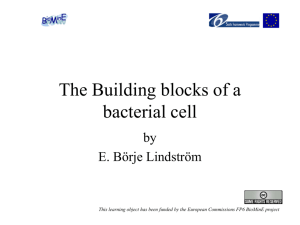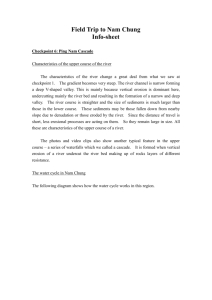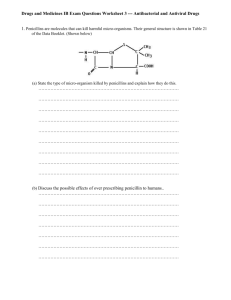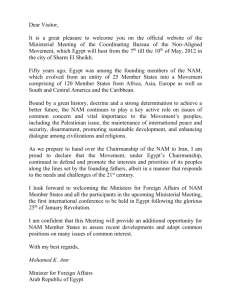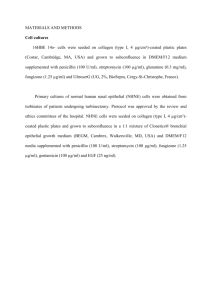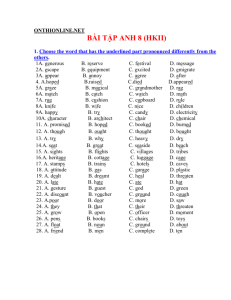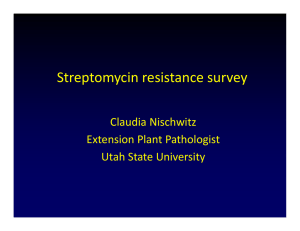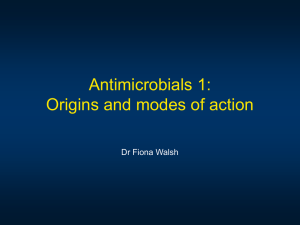Action of and Resistance to drugs and toxic metals
advertisement
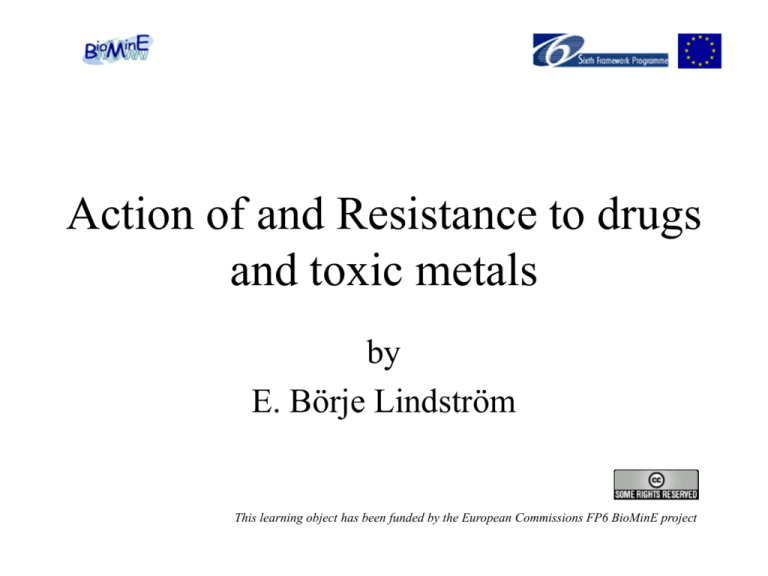
Action of and Resistance to drugs and toxic metals by E. Börje Lindström This learning object has been funded by the European Commissions FP6 BioMinE project Definitions • Chemoterapi: • Antibioticum: - Use of chemical substances against parasites in the host Substance that is produced by a microorganism and that: - inhibits growth of a micro-organism (-static) or - kills the micro-organism (-cid) Producers of antibiotics • Actinomycetes • Bacillus • Saprophytic fungi - Streptomyces - Bacillus - Penicillium, Cephalosporium Targets for some antibiotics Group Where Outside CM Target Cell wall synth Drug - Penicillin I - Bacitracin II III On CM Inside CM Permeability - Nystatin (Osmos) - Polymyxin • DNA repication - Nalidixic acid • RNA synthesis - Rifampicin • Protein synthesis - Streptomycin • Co-factor synthesis - Sulfa Penicillins (b-lactams) R: CH2 CH NH2 CO CO Pen G Amp Penicillins (b-lactams), cont • Action NAM – NAG – NAM – NAG – NAM – NAG L-ala D-glu L-lys (D-ala) D-ala D-ala D-ala L-lys Penicillins – block the synthesis D-glu L-ala NAM – NAG – NAM – NAG – NAM – NAG • Active only on growing cells • active against both G+ and G• broad spectrum • Lysis of the cell • bactericidal Penicillins (b-lactams), cont • Side effects on our cells? • Allergy? Penicellenic acid Penicilloyl – protein antigen protein Streptomycin • active against both G+ and G• broad spectrum • bactericidal Streptomycin, cont. • Targets (translation): - initiation complex - binding to 30S subunit RpsL-protein • Results: - misstranslation - faulty proteins Streptomycin, cont. • Used clinically? -selldom - against TBC • Side effects: -dizziness (balance difficulties) - lowering the hearing Note! The 80S ribosome is not effected! Sulfa drug • Sulfa drugs – not antibiotics – produced chemically • Growth factor analog PABA Sulfanilamide Folic acid (vitamin) CoF Sulfa drug, cont. • Acts as a competetive inhibitor in synthesis of Folic acid • CoF participates in several biosynthetic reactions – aa, purins etc. Type of resistance 1. Natural, artspecific resistance • no receptors are available • inactivating enzymes present 2. Acquired resistance Genetic processes: - Mycoplasma - penicillinase - sensitive m.o resistant m.o. • mutation • transformation • transduction • conjugation Type of resistance, cont. Biochemical mechanisms for acquired resistance: • permeability changes of OM or CM - penG, tetracyclin, actinomycin D • alternative biosynthesis or - sulfa increased production • changed receptor - streptomycin • enzym production - penicillinase Properties of a good antibioticum • Broad spectrum • Prevent resistant mutants to arise • Have no side effects on the human cell • Leave the flora of our body intact Effect on a growing cultur log OD/VC + drug log OD/VC OD + drug log OD/VC + drug OD OD VC VC t t Effect: - static VC - cid t - lytic Combined usage of antibiotics • Antagonism -drugs acting against each other - (-cid) + (-static) - e.g. Penicillin & kloramphenicol/ sulpha • Synergism - drugs enhancing their effect - (-cid) + (-cid) - e.g. penicillin + streptomycin Mercuric resistance • Action: -Bind to SH- groups - inhibits synthesis of macro molecules - most sensitiva are transcription and translation • Resistance: -usually plasid mediated - both in G+ and G-; S.aureus, Pseudomonads, At. thioxidans - enzymatic reduction; Hg2+ Hg0 - Hg0 less toxic - in organic mercury , C-Hg, Hg is first removed with the enzyme lyas. Mercuric resistance, cont. Arsenic resistance • Action: -AsO43- ions are transported into the cell via - phosphate-transport system - analog to PO43- ions - inhibits different kinases • Resistance: - plasmid mediated - AsO43- is reduced to AsO2- AsO2- is effluxed (transported to the outside) Arsenic resistance, cont. • Genetic: arsR arsD arsA arsB arsC E. coli R773 (plasmid) arsR arsB arsC Chromosome (At. caldus) • negative regulator • reductase
